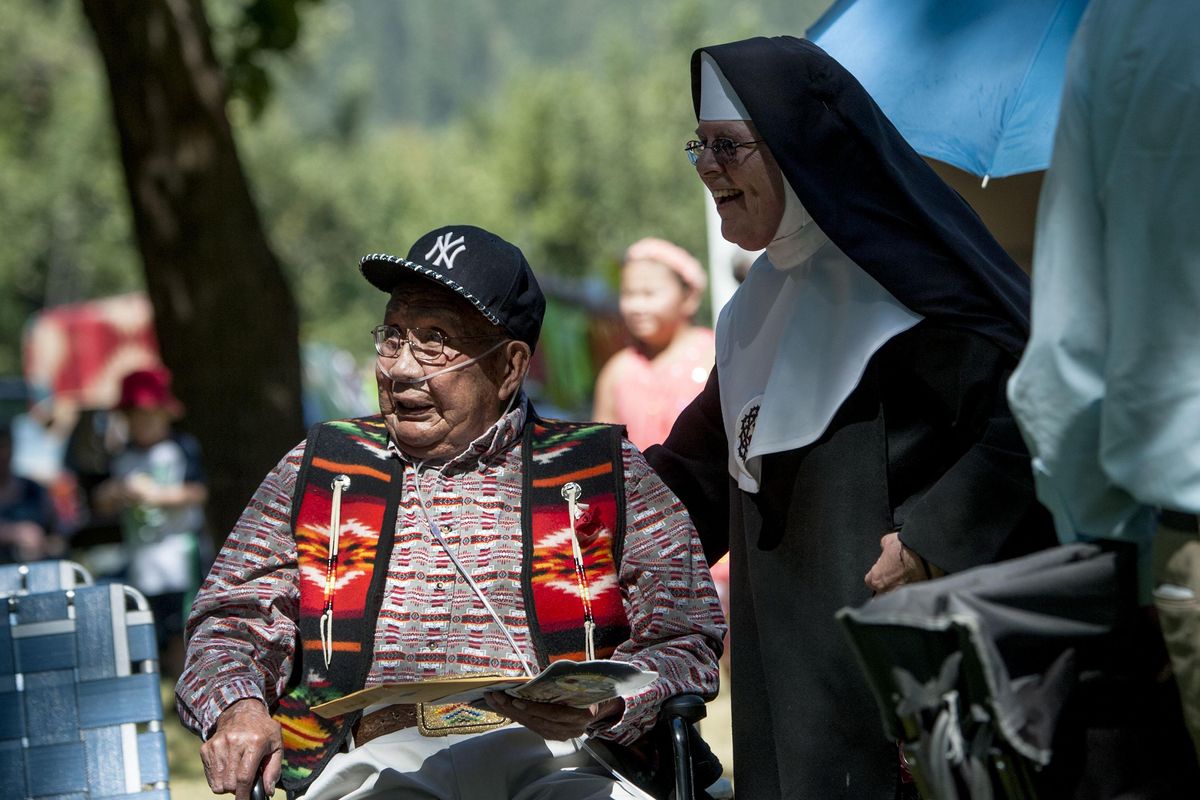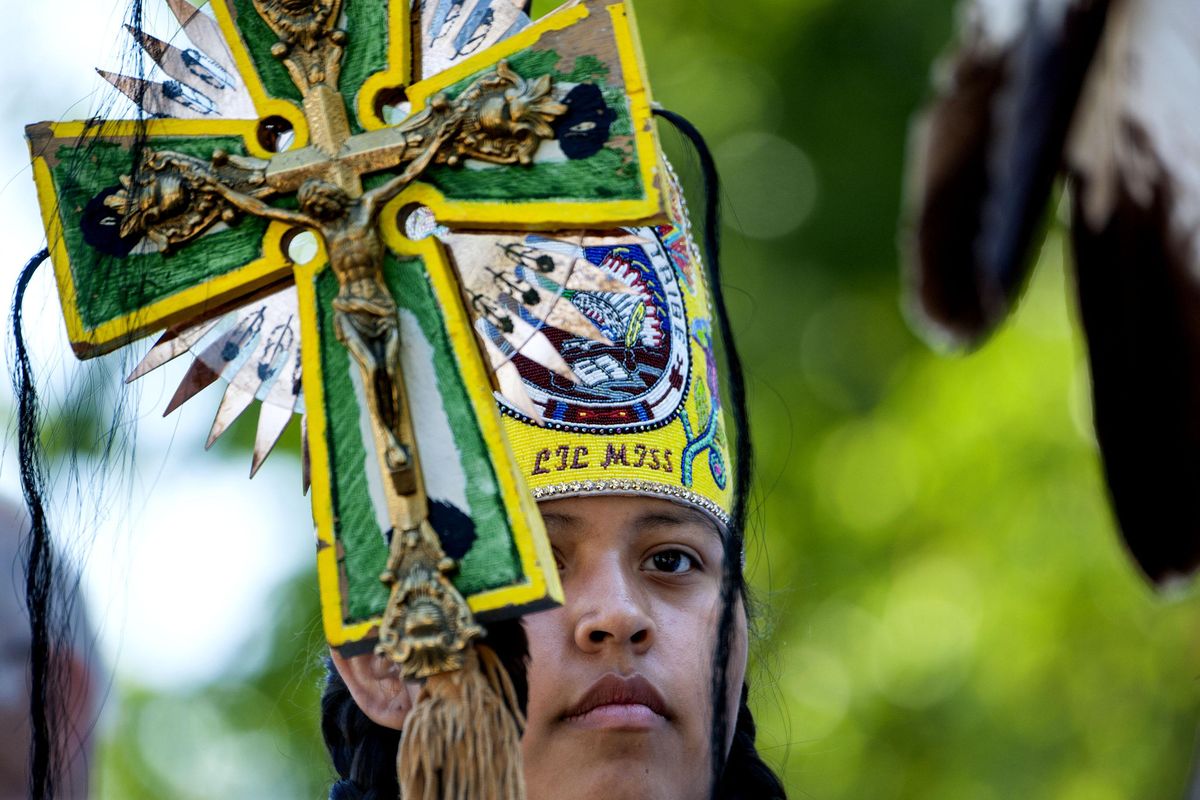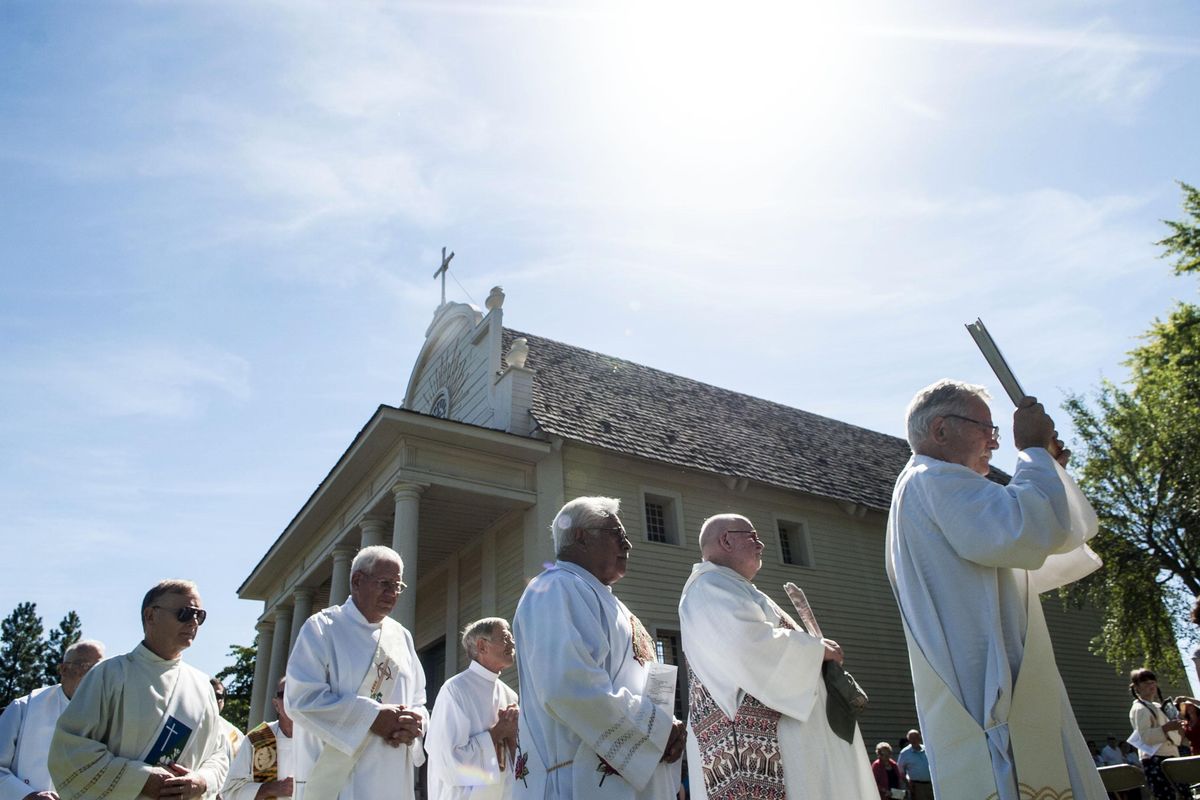Cataldo Pilgrimage a time to celebrate, share and heal
Lil’ Miss Coeur d’Alene, Nikisa Arthur, 15, of Plummer, Idaho, led the procession during the start of the Feast of the Assumption Mass at the 82nd annual Cataldo Pilgrimage at the Old Mission State Park in Cataldo, Idaho, Monday. (Kathy Plonka / The Spokesman-Review)Buy a print of this photo
CATALDO, Idaho – Close to 1,000 Catholics gathered Monday under the shade of linden, elm and maple trees next to Idaho’s oldest building for a culturally rich and reverent ceremony honoring the Virgin Mary and celebrating the bond between the church and the Coeur d’Alene Tribe.
The Feast of the Assumption was a highlight of the 82nd annual Cataldo Pilgrimage, which the tribe observes as a return to the river and to the mission its members built between 1850 and 1853 after meeting Jesuit missionaries.
Bishop Peter Christensen of the Diocese of Boise joined 20 priests and deacons in celebrating Mass on the day that Catholics observe the mother of Jesus being received into heaven. Christensen also used the occasion to rededicate the diocese to the Immaculate Heart of Mary.
The location along the Coeur d’Alene River was a natural choice, he said. “For here, in this holy land, is the advent of Christianity in the state of Idaho. It’s a place of grace.”
Mary is an example of generosity and faith in dark times – a fighter of evil, Christensen said.
“She’s here to help us. We need to entrust ourselves to her,” he said.
CeCe Curtis-Cook, a member of the tribe and a liturgy planner at Sacred Heart Mission Church in DeSmet, said the Cataldo Pilgrimage connects her with her people’s past.
“Since they built this church with their bare hands, they’ve been coming back every single year,” Curtis-Cook said. “It’s important to carry on those traditions and to be doing the same things that my ancestors were doing.”
She coordinated the celebration and sang parts of the Mass in the vanishing Coeur d’Alene dialect of the Salish language. During Communion she sang, “Qhest Jisu, qhest Jisu, ku’in whel whel tsuten,” which translates as “Good Jesus, good Jesus, you are my life-giver.”
The ceremony incorporated traditional drumming, singing and dancing of the tribe. The Coeur d’Alene Singers drum group sat directly behind the bishop and priests, and tribe member Andy Kitt performed the Cup Dance, honoring food from heaven, in traditional regalia adorned with feathers and bells.
“The culture is wonderful,” said Estela Gonzalez, of Post Falls.
She has been to the celebration half a dozen times, and her husband, George, a deacon at St. George’s Catholic Church in Post Falls, sat next to Bishop Christensen on Monday.
“I wish that I could understand their songs, I wish that I could understand the meaning of the drums,” Gonzalez said of the tribe’s role in the Mass. “But the people are very hospitable and they really make everybody feel welcome. … Our Blessed Mother really brings us all together as her children.”
After Mass the group shared a catered barbecue lunch as the hot sun blazed, followed by powwow-style dancing.
Marisela Baca, who grew up in Rathdrum and is the bishop’s executive assistant in Boise, attended the celebration at Cataldo for the first time Monday. She said it felt like a personal pilgrimage to make it there.
“It’s beautiful to see all the clergy together,” Baca said. “It’s nice to see such a diverse group of people here. It’s like a family reunion of sorts.”
Sister Paschalina Marie of the Sisters of Mary, Mother of the Church, a Spokane order, also attended for the first time and described the Assumption Mass as a blessing.
“For me, it’s a huge reflection of the openness of faith of the native peoples,” Sister Marie said. “To see that generations of the Coeur d’Alene Tribe are so faithful in keeping this pilgrimage and so open to sharing that with us who share the same faith in the one family of God, yeah, it’s beautiful, it’s beautiful.”
Prepared for Jesuit missionaries by the vision of an ancestral chief, the Coeur d’Alenes readily converted to Catholicism in the 19th century.
For Curtis-Cook, the blend of Catholic and tribal traditions at the Cataldo Pilgrimage reconciles the wrongs of the past, like early efforts of the church in the West to strip native peoples of their customs and language.
“There’s healing that’s taking place, I feel,” she said.







